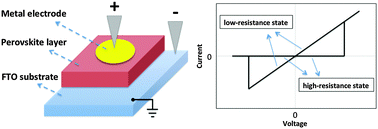High-performance perovskite memristor based on methyl ammonium lead halides†
Abstract
Memristors are devices that can store and process information based on their switchable internal resistance. Although these devices offer better performance than the conventional technology, the use of materials such as complex metal oxides usually requires high-temperature annealing processing or vacuum processing such as sputtering, which complicates the fabrication of the devices and hinders their development for practical use. Here we show a high-performance memristor based on organometal trihalides and electrochemical active metals, which achieved an on–off current ratio of 1.9 × 109. The devices can be solution-processed at low temperature and in air, which may be further developed into printable electronics. We explored the influence of different metal electrodes and device structures on memristor performance and the results indicated the great potential of methyl ammonium lead halide perovskite for information storage and computing. Our work provides new application prospects for these materials and may also contribute to the better understanding of other perovskite-based optoelectronic devices.


 Please wait while we load your content...
Please wait while we load your content...